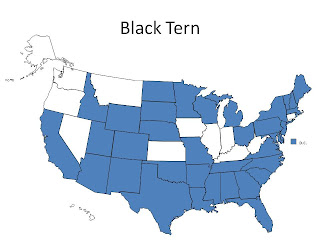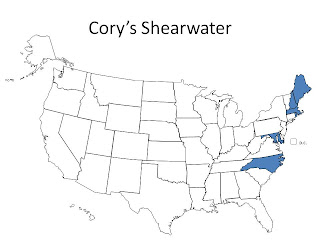The greatest possibility for new statebirds for me in Vermont is generally in the northwest part of the state. Between Lake Champlain’s waterbirds more typically seen on the coastal, a wide assortment of shorebirds at Dead Creek Wildlife Management Area, and the grassland birds of the Champlain Valley, there is a lot of potential. Unfortunately, northwestern Vermont is more than a 3-hour drive for me, so I don’t get up there very often. So when a rarity shows up there, although it is very tempting to make the trek to give it a try, I don’t often go.
This summer there have been frequent posts of a Brant hanging out at Dead Creek, along with a Snow Goose, mixed in with the local families of Canada Geese. Brant is certainly a good bird for Vermont, especially in summer, and it would be a new statebird. Plus this is the first long-staying, reliable Brant I can remember for VT. So with all these factors coming together, I decided to make the drive and give it a go. With the company of my good birding friend Denny Abbott of NH, we headed to Brilyea Access at Dead Creek to look for the Brant. When we arrived, several other birders were there looking at some shorebirds at the edge of the marsh. We asked if anyone had seen the Brant, and one birder mentioned it had just flown to the west with a flock of Canadas. Remembering that our goal was to find the Brant, we quickly got back in the car and took a short drive west to look for the geese. There is a large farm pond just a couple hundred yards west of the Brilyea Access, so we expected to find the geese there. However, there were no geese there of any species. We continued to drive a bit farther west and noticed a small flock of Canadas “grazing” in some tall grasses along the road – it has to be in this flock, right? But Denny and I easily searched through the geese and only saw Canadas, even though the birds were somewhat obscured by the grass. Then I wondered if we weren’t seeing the smaller Brant because it was completely hidden by the grass. Sure enough, with some closer scanning, I saw a small black head (but only the head) stick up above the grass. And it was only visible for a few seconds at a time. Not the best of views, but still a definitive Brant. We would have never seen the Brant if we hadn’t gotten the tip from the other birders at Dead Creek!
Denny and I then went back to Brilyea Access to join the other birders and thank them for their information on the Brant. When we returned, they were looking at the shorebirds on the nearby mudflats. There were only a few, but with considerable diversity – both yellowlegs, a Dowitcher, several Least Sands, a couple Semi Sands, a couple Baird’s Sandpipers, and of course a couple Killdeer. We spent a lot of time on the peeps, and eventually felt good about the IDs. Then one birder started asking if the Dowitcher could be a Long-billed. (Amazing that during all that time we didn’t pay much attention to the Dowitcher!) Then with a little scrutiny, we saw that the bird was an adult, and rather uniformly orangy below, which would mean if it was a Short-Billed it would have to be one of the Henderson’s race. Then we noted how dark the back was – no pale edges to the scapulars. Could that be a reasonably definitive field mark for Long-billed? There was some limited barring over much of the flanks.
I took a couple phone-scoped photos of the bird shown below – the first shot shows the very dark back.
 |
| I can't figure out how to turn this picture! |
Then I took the following picture and was lucky enough that the bird had its entire bill exposed from the mud. Wow – it’s really long! I showed the photo to the other birders and none of us realized how long the bill was until then since it was actively feeding and at least a portion of the bill was always in the mud.
 |
| Another sideways photo - ugh! |
A few salient features that I didn't know about until reading this article -
· Loral Angle - the angle between the bill line and a line going through the eye (my poor description). Basically, the Short-billed eye averages being higher on the head than the Long-billed. The photo I took with the bird facing us shows a very low loral angle indicating Long-billed.
· Bill Shape - Short-billed more likely to be a bit downcurved and Long-billed is very straight. This bird had a very straight bill as shown in the picture with the entire bill exposed
· Scapulars and Greater Coverts in Worn Alternate Plumage. Wear of these feathers on Short-billed results in deeply pointed appearance to the feathers - on Long-billed the appearance is square or blunt-tipped. Again a vote for Long-billed based on the photo showing the exposed bill. "Because Short-billed shows more extensive white edges than Long-billed, this feature is often still preserved in worn alternate plumage, such that late-summer Long-billeds appear very dark-backed while Short-billeds appear lighter-backed from a distance." I had not noticed this in the past, but other birders there seemed to key in on this very quickly.
· Molt Timing - "Long-billeds molt their primaries during migration whereas Short-billeds wait until they arrive at their wintering grounds to molt their primaries." The molted primaries are visible in my photo showing the exposed bill. Another Long-billed vote.
· I really think that the color of the undersides, and the patterns on the side, are inconclusive except that it's either Long-billed or Short-billed hendersoni.
So along with the really long bill, I've got to believe it was a Long-billed.
I didn't realize that all the North American dowitchers were considered to be 1 species until the 50's - I can certainly understand why.
That gives me 3 new statebirds for VT this year – 246 now. My statebird maps for Long-billed Dowitcher and Brant are below. My sightings of the dowitcher are especially spotty in the eastern US. While for Brant, VT is my first inland state - otherwise my sightings are in all the typically Pacific and Northeast states.
 |
| Statebird maps - colored blue in states where I've seen it |


























